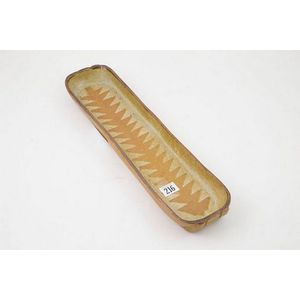Pair of George III Silver Toothpick Cases
Two George III brightcut sterling silver toothpick cases, Samuel Pemerton / Brimingham / late 18th century, each elongated rectangular in form with chamfered corners, and bright cut decoration overall. Date marks worn to both., approximately 51 gms silver, 8.5 cm, 2.7 cm, 1 cm and 7.5 cm, 1.8 cm, 1 cm
You must be a subscriber, and be logged in to view price and dealer details.
Subscribe Now to view actual auction price for this item
When you subscribe, you have the option of setting the currency in which to display prices to $Au, $US, $NZ or Stg.
This item has been sold, and the description, image and price are for reference purposes only.
- Bright Cut Decoration - Bright cut decoration is a technique used to decorate silver and other metal objects, such as jewellery and flatware, with intricate and detailed patterns. The technique involves using a small, sharp tool called a graver to carve designs into the surface of the metal. These designs are then polished, creating a bright, reflective surface that contrasts with the surrounding metal. The designs can be simple or complex, and can include geometric shapes, scrolling vines, and other decorative elements. The technique is highly skilled and requires a lot of precision, patience and attention to detail.
Bright cut decoration was widely used in the 18th and 19th centuries, particularly in the silverware and jewellery industries. It was popular in the United States, Great Britain and Europe.
Today, bright cut decoration is still used by some craftsmen and artists, but it is considered a traditional technique and is not as widely used as it was in the past. However, the bright cut decoration on a silver object is still considered a sign of quality and craftsmanship and is highly prized by collectors of antique silver and other metal objects. - Sterling Silver - Sterling silver is a mixture of 92.5% pure silver and 7.5% of another metal, usually copper. Fine silver is 99.9% pure silver, and is relatively soft and the addition of the very small amount of copper gives the metal enough strength and hardness to be worked into jewellery, decorative and household objects.
- George Iii - George III (1738 - 1820) was King of Great Britain and Ireland from 1760 to 1820.
- Bevel / Chamfer - In furniture making, a chamfered corner refers to a technique used to create a smooth, angled edge on the corner of a piece of furniture. This is typically done by cutting away a small portion of the corner at an angle, typically 45 degrees, creating a diagonal edge, rather than a sharp 90-degree angle. This technique can be used on various parts of a piece of furniture such as table legs, drawer fronts, or door frames. Chamfering can add visual interest to a piece and can help to soften the overall look of a piece of furniture. It is often used in conjunction with other techniques, such as rounding edges or using contrasting wood species to create a more elegant, sophisticated look. Chamfering is a simple way to add a touch of elegance to a piece of furniture and it is a common technique used by furniture makers.
This item has been included into following indexes:
Visually similar items

A silver pocket knife, machine turned detail; Thomas turner & Co, Sheffield, 1934.
Sold by
in
for
You can display prices in $Au, $US, $NZ or Stg.

Sold by
in
for
You can display prices in $Au, $US, $NZ or Stg.

A pair of diamond earrings, each of oval hoop design, channel set with round brilliant cut diamonds, mounted in 18ct gold.
Sold by
in
for
You can display prices in $Au, $US, $NZ or Stg.

Aboriginal incised hardwood shield. Provenance: A former diplomatic family based in the ACT (collection formed in the 1950s & 60s); by descent to the current owner, length 66.5 cm
Sold by
in
for
You can display prices in $Au, $US, $NZ or Stg.
